The Courage to Show Up and Be Seen

Connection is the energy that is created between people when they are seen, heard, and valued — when they can give and receive without judgement.
– Brené Brown
At Opal School, we see all children as curious and competent citizens with rights. We see them driven to connect and eager to be understood. We know that the arts are powerful pathways to developing understanding of ourselves, each other, and complex ideas.
With this in mind, our hope is for all of us — both children and adults — to continue to build our understanding of what it means to be a citizen in this complicated and uncertain world. We hope to nurture courageous thinkers, collaborators, and change-makers.
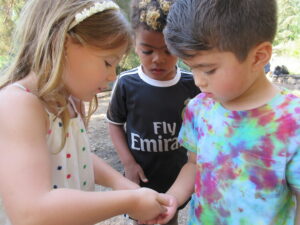
We believe learning happens when people form relationships with one another, ideas, materials and the environment. All of our work in the classroom relies on relationships: they form the taproot for teaching and learning.
In the first week of school, the teachers are curious about the ways that the children are using the natural learning strategy of play to grow their relationships. We wonder, How does playing with materials, ideas and each other support the children to practice being courageous? What’s the relationship between being brave and building a strong community where everyone belongs?
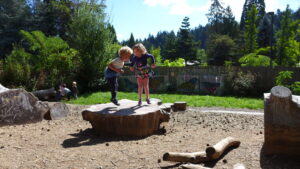
Play supports children to practice being vulnerable and taking chances. When placing their idea, question, or story into the world, they trust that it will be met with care and compassion. These next two slices of dialogue illustrate the children’s strong desire to connect with and care for one another through play.
I don’t know how to write an M
Ivy to Caroline: Can you help me write “Mom”?
Caroline: Hmm, let’s think about this together. (Caroline stretches the word Mom out, emphasizing the mmm sound.) Does that sound connect to a letter that you already know?
Reece: M! (He is making a rainbow drawing to put in an envelope for his family.)
Ivy to Caroline: I don’t know how to make an M. (Caroline shows her in the air: start at the bottom, go up, then down, then up, then down again).
Ivy writes an N.
Reece: That’s not an M.
Ellie leans over to look at Ivy’s paper and then adds a line to turn her N into an M.
Ivy smiles and says, Thanks.
Ivy: What comes next?
Reece: A! I mean, no, O!
Ivy writes an O.
Reece: Then M.
Ivy again writes an N
Again, Ellie leans over and draws the line for her, making it into an M.
Ivy: Thanks!
In this moment, I see a teacher who believes in the children’s capacities to construct their understandings through their relationships. I see that Ivy takes a chance and asks, “Can you help me?” I see a small group of children who are eager to support one another in gentle and non-judgmental ways. In order to say “I don’t know how,” I imagine Ivy feels this is a safe place to be vulnerable. I noticed that she moved from stuck to unstuck through playing with letters and words and sharing enthusiasm for writing with new friends.
I wonder, what messages are we sending children that support their belief that they are resources to one another so early in the school year? What habits of mind does each child rely upon in this exchange? What can we learn from children how to be comfortable with uncertainty? What questions was the teacher asking herself as she observed this moment?
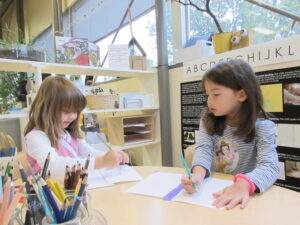
Are you still my friend?
During Explore, Bella calmly walked over to Caroline and said: When Blaire left the sand, she said ‘I’m done here.’ I think she is not wanting to be my friend anymore.
Caroline: Are you asking me for help to talk with Blaire?
Bella: Yes
Caroline: I’d love to help. Do you know what you want to ask Blaire?
Bella nods
They walk over to Blaire, who has moved to the Message Center.
Bella: Blaire, are you still my friend?
Blaire: Yes, we’re friends!
Bella: When you said “I’m done here” I thought you were saying that you didn’t want to be my friend anymore.
Blaire: No, we are friends. I was just wanting to come to the Message Center.
Bella then joins the children at the message center table and makes Blaire a drawing, a gift of hearts.
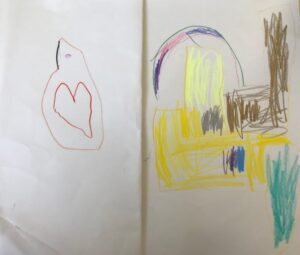
I notice that Bella cares deeply about her friend, Blaire, yet she’s still constructing her understanding of friendship. I see that Bella is intrinsically motivated to fix the problem, and Caroline’s questions keeps her moving in that direction. I notice the role of listening, dialogue and exchange in forming relationships to ideas and each other. I see Caroline’s belief that children are competent in this transcript and in the act of documenting it.
I wonder, how did this experience shift Bella’s growing understanding of the complexities of friendship? How will this interaction support her the next time she bravely asks a question?
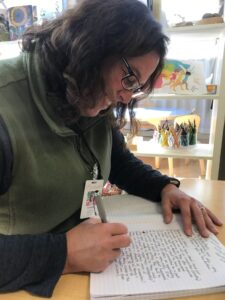
Caroline’s Reflection
This week, my focus is to pay attention to the ways that children are seeking connections with one another and trying to capture these in photos and in my journal. I know that it can feel really scary to put your voice – your ideas, questions, and stories – out into the community when you don’t know how your community will receive it. I have been amazed at all of the ways that children are bravely seeking connection with one another. I was so inspired and excited to see Ivy courageously admit to both me and her peers that she needed help and how willingly she accepted support from us all. She was sending a message to her community that she knows that this is a place that she can be vulnerable and ask for help and she will gladly receive this help. In the story with Bella and Blaire, I witnessed how brave Bella was in asking Blaire if they were still friends, as she had no idea what the answer would be, and I know how hurt she would feel if Blaire’s response had been negative. She sought out the support that she needed (by asking me to accompany her) to allow her to ask Blaire if they were still friends. The joy Bella felt afterwards was palpable. She was buzzing! It reminded me of when you get ready to try something new and you are nervous, but then you do it, and you feel elated as you now know that you are capable, competent and strong in a way that you had not yet discovered about yourself. I was witnessing Bella’s joy in showing up and being met with “You are a part of this community.” These small moments that are happening all of the time, and are shaping our learning community and how we want to be together. We have so much to learn from children about bravery, showing up, feeling uncertain, taking risks, seeking connection and working together, setting aside our ego.
Dear Reader,
In these short stories, where do you see evidence of courage, collaboration and change-making?
What stories about being brave and taking risks are showing up in your classroom?
